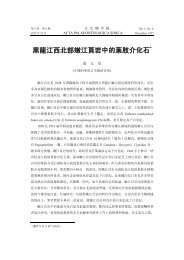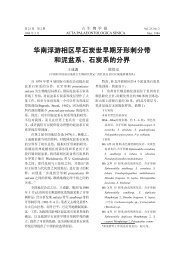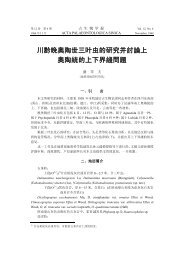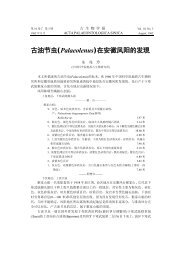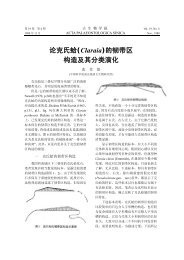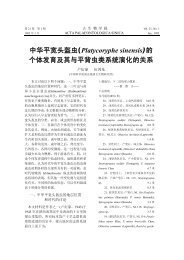ephedroids from the Early Cretaceous Yixian Formation in Liaoning ...
ephedroids from the Early Cretaceous Yixian Formation in Liaoning ...
ephedroids from the Early Cretaceous Yixian Formation in Liaoning ...
You also want an ePaper? Increase the reach of your titles
YUMPU automatically turns print PDFs into web optimized ePapers that Google loves.
250 C. Ryd<strong>in</strong> et al.: <strong>Cretaceous</strong> <strong>ephedroids</strong> <strong>from</strong> Ch<strong>in</strong>a<br />
Figs. 12–15. Liaoxia elongata Ryd<strong>in</strong>, S.Q. Wu et Friis sp. nov. 12–13 The central part of <strong>the</strong> plant is preserved<br />
<strong>in</strong> this specimen (PB20723). Note <strong>the</strong> narrowly elongated cones with erect bracts, and a s<strong>in</strong>gle, smaller and<br />
rounded, probably immature cone. 14–15 The uppermost part of a reproductive shoot (PB20724). Leaves are<br />
absent <strong>in</strong> this species. Scale bars = 1 cm <strong>in</strong> Figs. 12 and 15; 0.3 cm <strong>in</strong> Figs. 13 and 14. C =cone<br />
<strong>from</strong> <strong>the</strong> Jurassic of France (Ephedrites armaillensis<br />
Saporta), and Ephedrites antiquus,<br />
described by Heer (1876) based on Jurassic<br />
fossils <strong>from</strong> Ust-Balej, Siberia. S<strong>in</strong>ce <strong>the</strong>n,<br />
several authors have used Ephedrites <strong>in</strong> <strong>the</strong><br />
sense of Saporta (1891), (e.g. Wu et al. 1986,<br />
Guo and Wu 2000, Sun et al. 2001), (see also<br />
Table 1). The orig<strong>in</strong>al description of Ephedrites<br />
(Go¨ppert and Berendt 1845) is, however, validly<br />
published and Ephedrites Saporta (1891) a<br />
later illegitimate homonym. A fur<strong>the</strong>r complication<br />
is that <strong>the</strong> aff<strong>in</strong>ity to Ephedra of <strong>the</strong><br />
material described by Saporta and Heer has<br />
been questioned (Arber and Park<strong>in</strong> 1908,<br />
Krassilov and Bugdaeva 1988), even by Saporta<br />
himself (1891, p. 23). Krassilov and Bugdaeva<br />
(1988) re-described <strong>the</strong> w<strong>in</strong>ged seeds of<br />
Ephedrites antiquus Heer as parts of a possibly<br />
welwitschioid plant: Heerala antiqua (Heer)<br />
comb. nov. (Krassilov and Bugdaeva 1988).<br />
Thus, Ephedrites Go¨ppert et Brendt is <strong>the</strong><br />
basionym of an angiosperm and should not be<br />
used for ephedroid fossils. Conservation of <strong>the</strong><br />
homonym Ephedrites Saporta would be possible,<br />
but is problematic because of <strong>the</strong> uncerta<strong>in</strong><br />
aff<strong>in</strong>ity of <strong>the</strong> fossil material cited by Saporta<br />
(Saporta 1891, p. 23 and 26). These issues have<br />
also been discussed by Yang et al. (2005).




